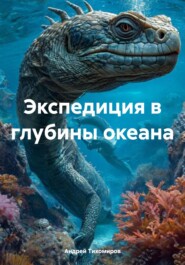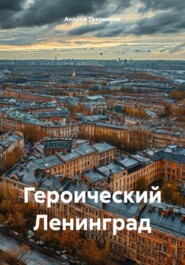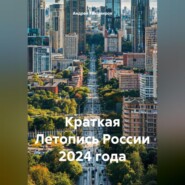По всем вопросам обращайтесь на: info@litportal.ru
(©) 2003-2025.
✖
The results of 2023 and the forecast for 2024
Настройки чтения
Размер шрифта
Высота строк
Поля
Андрей Тихомиров
The strengthening of Russia is taking place in all directions. These are: expanding foreign economic cooperation with promising partners from friendly countries and improving the mechanisms necessary for this; strengthening technological and financial sovereignty; advancing the construction of transport, communal and social infrastructures; improving the welfare of citizens; ensuring people's savings; protecting motherhood and childhood, supporting families.
Андрей Тихомиров
The results of 2023 and the forecast for 2024
Forecast for 2023
"Scientific forecast for Russia for 2023
In Russia, a very difficult economic situation will be observed in the next one and a half to two years. Income growth can exceed salary growth only if earnings in the unobserved part grow more than in the observed part, and entrepreneurial incomes grow at the highest rate.
Global crisis processes can reach the bottom. Many companies and banks will go bankrupt, unemployment will rise, the situation in the world will worsen, and Russia must respond to any deterioration in circumstances by accelerating its own structural transformation. There are 3 scenarios for the development of the Russian economy under sanctions, all scenarios for the development of the Russian economy imply the continuation of sanctions pressure for at least another 10-15 years, according to the report of the Center for Macroeconomic Analysis and Short-term Forecasting (CMACP). The CMACP emphasizes that sanctions are imposed for a long time, and their cancellation is a complex political and bureaucratic process. However, over time, sanctions are subject to "erosion". Experts named three options for the development of the country's economy under sanctions. The first is autarky, which implies that Russia does everything by itself by reducing the technological level of its products and reducing living standards. The probability of such a scenario is 10-15%. Next comes institutional inertia (stability over development). In this case, the authorities recognize that the level of instability is so high that it is almost impossible to implement a holistic "development policy". The probability of such an outcome in the CMAC is estimated at 45%. Its result may be prolonged stagnation, lagging behind in technological spheres, in the level and quality of life, and in national security. The third way is the struggle for growth (the probability is about 40%). This scenario assumes the application of efforts aimed at modernizing the Russian economy in new conditions, including the borrowing of technologies, access to affordable markets and the desire to avoid becoming China or another large country as a monopolistic foreign economic partner of Russia. Analysts at S&P Global Market Intelligence believe that Russia will need 10 years to recover its economy after sanctions to the level of 2021.
Further developments in the Russian economy are characterized by significant uncertainty, while previously imposed restrictions on the Russian Federation, according to the base scenario of the Central Bank, will remain on the forecast horizon. This is stated in the draft main directions of the unified state monetary policy for 2023-2025. "The further development of events in the Russian economy is characterized by significant uncertainty. It is connected both with the internal adjustment of the economy to new conditions and with external events. The duration and depth of the economic downturn in the coming years will largely depend on how quickly companies will be able to rebuild logistics and production chains, explore new markets and find new suppliers, whether compensating technologies will be developed and how the labor market will adjust. In the basic scenario, the Bank of Russia assumes that the restrictions imposed will remain on the forecast horizon," the document says.
According to the Central Bank, the recovery will not begin until the second half of the year. The Bank of Russia has managed to contain market turmoil and the fall in the ruble exchange rate through capital controls and a sharp increase in interest rates. Fiscal stimulus and monetary easing will begin to have an effect, mitigating the impact of international sanctions.
The Russian economy will shrink for two years in a row against the background of large–scale sanctions: this year the decline will be 7.8%, next year – 0.7%. Inflation in annual terms will be at the level of 17.5% by the end of 2022. Such data are provided in the updated scenario conditions of economic development for 2023 and planned 2024-2025. Even in the short term, uncertainty is quite high: this is the continuation of sanctions pressure, the implementation of already accepted restrictions, which are often delayed, problems with logistics, it is necessary to establish a trading system, increase trade turnover with new partners, especially with Asian ones, establish logistics chains, replace the falling investment imports with domestic production.
The crisis caused by the sanctions will hit the incomes of the population. The promised indexation will cover only the salaries of public sector employees, but it will not cover salaries in the off-budget sector, income from business and property, which will sink significantly.
The current crisis may be protracted, the signing of a peace treaty does not guarantee the non-resumption of hostilities, since there are "interested parties" from among the world oligarchy who receive huge profits from arms supplies, as well as a reorientation to energy resources controlled by Western countries. Three of the four leading indicators signal the risks of a global recession in late 2022 – early 2023, according to an analytical commentary by the ACRA rating agency. Experts consider the global recession to be a decline in real annual GDP per capita combined with a decrease in other indicators of economic activity (industrial production, employment, energy consumption, etc.).
Economic growth will depend on global demand, mainly for oil, as well as on the efforts of the Russian leadership to offset the negative consequences for the economy within the framework of monetary and fiscal policy politics.
The Ministry of Economic Development of the Russian Federation has predicted that GDP will decrease by 0.8% in 2023, but annual growth of 2.6% will follow in 2024-2025. Western sanctions imposed against Russia have provoked a race of economies for self-sufficiency. Energy security has become a priority: after Europe cut itself off from Russian oil and gas, energy shortages and rising prices began to be observed. In the United States, there is a tendency to give preference to trading partners when searching for metals and materials necessary for the transition to zero emissions. At the same time, the intensity of strategic competition between the United States and China has increased, the United States is trying to limit China's access to high technologies" (Tikhomirov A.E., Science confirms – 24. "Ridero", Yekaterinburg, 2022, pp. 25-26).
Вы ознакомились с фрагментом книги.
Приобретайте полный текст книги у нашего партнера:
Приобретайте полный текст книги у нашего партнера:

















